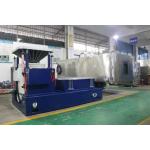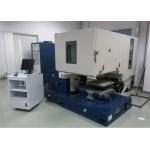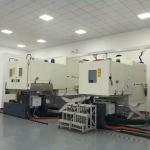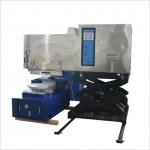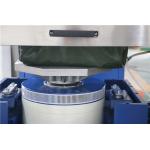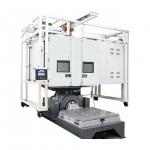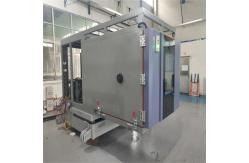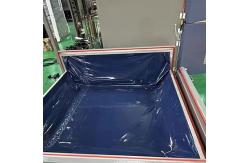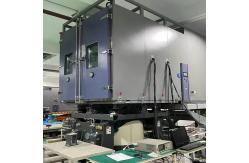In the highly demanding and safety-critical aerospace industry, the
performance and reliability of components are non-negotiable. The
Customized Climate Chamber with Vibration is a technological marvel
that offers a comprehensive solution for simulating the extreme and
multifaceted conditions that aerospace parts endure. This specialized chamber is designed to replicate the complex
combination of environmental factors and mechanical stresses that
aerospace components face during their operational lifespan. It
serves aerospace manufacturers, research institutions, and testing
laboratories. The primary goal is to evaluate how components such
as avionics, engines, and structural elements perform and survive
in the presence of simultaneous temperature and humidity
variations, as well as mechanical vibrations. By subjecting these
components to such realistic and harsh testing conditions,
engineers can identify potential weaknesses, optimize designs, and
enhance the overall safety and durability of aerospace systems. - Robust and High-Performance Construction
- The chamber is constructed with a heavy-duty, high-strength alloy
framework that can withstand the intense forces generated during
vibration testing and the rigors of extreme temperature and
pressure differentials. The exterior is made from
corrosion-resistant materials, ensuring long-term durability and
protection against the elements. The interior is lined with a
thermally conductive and vibration-damping material to promote
uniform temperature distribution and minimize any interference or
resonance caused by the vibrations. The door is a
precision-engineered component, featuring a multi-point locking
system and a high-quality sealing gasket. This ensures an airtight
and hermetic seal, preventing any leakage of conditioned air and
maintaining the integrity of the simulated environment. A large,
reinforced viewing window, made of tempered and anti-fog glass,
allows for real-time visual inspection of the testing process
without compromising the chamber's environmental or mechanical
integrity.
- Precision Temperature, Humidity, and Vibration Control Systems
- Temperature Control: Capable of maintaining an extensive
temperature range, from -70°C to +150°C, with an outstanding
accuracy of ±0.5°C. This is achieved through a combination of
advanced refrigeration technologies, including cascade
refrigeration for ultra-low temperature capabilities, and
high-power heating elements. The control system incorporates a
sophisticated feedback loop, with multiple temperature sensors
strategically placed throughout the chamber, ensuring uniform
temperature distribution and minimal temperature gradients. The
user-friendly control panel permits the programming of complex
temperature profiles, including rapid temperature ramps, extended
dwell times at specific temperatures, and intricate cycling
sequences, all of which are essential for replicating the dynamic
temperature changes experienced in aerospace applications, such as
during high-altitude flight or re-entry.
- Humidity Control: The humidity control system is equally precise,
with the ability to achieve humidity levels ranging from 5% to 95%
RH (Relative Humidity), with an accuracy of ±3% RH. It employs a
combination of steam injection humidifiers and desiccant
dehumidifiers, integrated with a carefully designed air circulation
system. The chamber is equipped with high-precision humidity
sensors that continuously monitor the internal humidity. The
control system then makes real-time adjustments to the
humidification or dehumidification processes, allowing for the
creation of stable or rapidly changing humidity environments. This
is crucial for testing the effects of moisture on sensitive
electronic components, such as circuit boards and connectors, as
well as the integrity of materials like composites and metals in
humid conditions, which are common in various aerospace scenarios,
from tropical takeoffs to high-altitude condensation.
- Vibration Control: The vibration system is a marvel of engineering,
capable of generating a wide range of frequencies and amplitudes.
It can produce vibrations from a few hertz up to several kilohertz,
with amplitudes adjustable from a fraction of a millimeter to
several centimeters. The vibration table within the chamber is
designed to provide a highly uniform and controlled vibration
field, ensuring that all parts of the tested component experience
the same mechanical stress. The control system allows for the
programming of complex vibration waveforms, including sinusoidal,
random, and shock waveforms, mimicking the diverse vibration
patterns that aerospace components encounter, such as engine
vibrations, turbulence-induced vibrations, and the shock of landing
or takeoff. The vibration system is also equipped with
accelerometers and displacement sensors to accurately measure and
monitor the applied vibrations, ensuring the repeatability and
accuracy of the tests.
- Advanced Instrumentation and Data Acquisition
- The chamber is outfitted with a comprehensive suite of sensors and
instrumentation. In addition to temperature, humidity, and
vibration sensors, it includes pressure sensors to monitor any
changes in air pressure that could impact the test results or the
performance of the samples. Strain gauges can be incorporated to
measure the mechanical strain on components during vibration and
temperature cycling. These sensors are connected to a
state-of-the-art data acquisition system that records and stores
all relevant data. The data acquisition system offers a high
sampling rate, typically ranging from 1000 to 5000 samples per
second, ensuring that even the most rapid changes in environmental
conditions, vibration parameters, or sample performance are
accurately captured. The collected data can be accessed and
analyzed in real-time or retrieved later for in-depth studies. The
system is also compatible with specialized aerospace data analysis
software, enabling the generation of detailed reports and graphical
representations of the test results, which are essential for making
informed engineering decisions.
- Enhanced Safety and Compliance Features
- The Customized Climate Chamber with Vibration for the Aerospace
Industry is designed with multiple layers of safety features. It
incorporates an automatic emergency shutdown system that activates
immediately in the event of any critical malfunction, such as
overheating, overcooling, excessive humidity, or a vibration system
failure. The chamber is equipped with a fire suppression system,
which can quickly extinguish any potential fires that may occur due
to electrical faults or sample failures. The ventilation system is
engineered to remove any harmful gases or fumes that may be
generated during the testing process, protecting both the samples
and the operators. The control panel is designed with safety
interlocks and clear warning indicators to prevent accidental
operation and ensure the well-being of personnel. Additionally, the
chamber complies with all relevant aerospace industry standards and
regulations, such as MIL-STD-810 for environmental testing of
military equipment and RTCA/DO-160 for avionics. This compliance
ensures that the testing procedures are recognized and accepted by
regulatory bodies and industry stakeholders, facilitating the
certification and deployment of aerospace products.
- Chamber Size and Capacity: With a net volume ranging from a few cubic meters to larger sizes
suitable for testing entire aerospace subsystems or small-scale
prototypes, the chamber offers flexibility in accommodating
different component sizes and quantities. The interior dimensions
are carefully designed to ensure proper air circulation, uniform
temperature and humidity distribution, and effective vibration
transmission. For example, a medium-sized chamber might have
interior dimensions of 2 meters x 2 meters x 3 meters, providing
sufficient space for testing a single jet engine component or a
small avionics rack while maintaining the accuracy and integrity of
the simulated environment.
- Temperature Cycling Rate: The chamber can perform temperature cycles at a rate of 2 to 5
cycles per hour, depending on the specific requirements of the test
protocol. For example, it can rapidly cool from +80°C to -50°C in a
matter of minutes and then heat back up, subjecting the samples to
significant thermal stress. The ramp rate can be adjusted,
typically ranging from 1°C per minute to 20°C per minute, allowing
for the simulation of different thermal profiles, such as the rapid
temperature changes experienced during supersonic flight or the
slow temperature gradients in orbital conditions.
- Humidity Cycling Rate: The humidity can be cycled within 15 to 30 minutes, allowing for
the simulation of rapid changes in moisture conditions. This
replicates the transitions that may occur, for example, when an
aircraft moves from a dry, high-altitude environment to a humid,
low-altitude landing zone or vice versa. The chamber can quickly
adjust the humidity level from a low value, such as 10% RH, to a
high value, such as 90% RH, and back, enabling the evaluation of
the component's response to such changes, especially in terms of
corrosion, electrical conductivity, and material integrity.
- Vibration Frequency and Amplitude Range: The vibration system can generate frequencies from 5 Hz to 5000
Hz, covering the typical frequency range of aerospace vibrations.
The amplitude can be adjusted from 0.1 mm to 50 mm, depending on
the specific test requirements. For example, during engine
vibration testing, frequencies in the range of 100 Hz to 1000 Hz
with amplitudes of a few millimeters might be applied, while for
shock testing related to landing or takeoff, higher amplitudes and
shorter-duration shock pulses at lower frequencies, such as 5 Hz to
50 Hz with amplitudes up to 50 mm, could be used.
- Data Acquisition Rate: The data acquisition system samples sensor data at a rate of 3000
samples per second, ensuring that even the slightest and most rapid
changes in temperature, humidity, pressure, vibration, or strain
during the test are accurately recorded. This high sampling rate
provides engineers and scientists with detailed and accurate
information about the performance and behavior of the tested
samples, enabling them to identify potential issues and make
informed design improvements.
- Compliance with Industry Standards: The chamber is fully compliant with MIL-STD-810, which covers a
wide range of environmental conditions and test methods relevant to
military and aerospace equipment, and RTCA/DO-160, which focuses
specifically on the environmental testing of avionics. This
compliance ensures that the testing is conducted in accordance with
the strict requirements and procedures established by the aerospace
industry, providing confidence in the reliability and performance
of the tested products.
- Accurate Simulation of Aerospace Operational Environments
- The primary function of this chamber is to provide a highly
accurate and realistic simulation of the temperature, humidity, and
vibration conditions that aerospace components will face during
their operational lifespan. By precisely controlling these
parameters, it allows for the evaluation of how components and
systems will perform and degrade over time. For example, it can
determine if an avionics system will experience malfunctions due to
overheating and vibration-induced stress in a hot and turbulent
flight environment or if a satellite component will withstand the
extreme temperature and vibration conditions during launch and
orbital operations. This information is invaluable for aerospace
engineers to optimize their designs, select appropriate materials,
and improve the overall reliability and durability of their
products.
- The ability to conduct repeatable tests with different temperature,
humidity, and vibration profiles, as mandated by industry
standards, is also a crucial function. This helps in comparing the
performance of various product designs or manufacturing processes
and identifying the most suitable solution. For instance, a defense
contractor can test multiple prototypes of a new missile guidance
system under the same set of temperature, humidity, and vibration
cycling conditions and analyze the results to select the most
reliable and accurate design.
- Enhanced Aerospace Product Quality and Mission Success Assurance
- Through comprehensive testing in the Customized Climate Chamber
with Vibration, aerospace product developers can identify and
address potential issues in their designs. If a component shows
signs of failure or degradation during the test, appropriate
measures can be taken, such as modifying the material composition,
improving the manufacturing process, or adding additional vibration
damping or thermal protection features. This leads to the
development of more reliable and durable aerospace products,
reducing the risk of mission failures and enhancing the safety of
personnel. In the research and development field, it allows for the
exploration of new materials and technologies, providing valuable
data on their behavior under extreme temperature, humidity, and
vibration conditions. For example, researchers can study the
performance of new composite materials for aircraft structures or
advanced vibration isolation systems for sensitive avionics.
- The chamber also serves as a powerful tool for quality control. By
subjecting products to standardized environmental and vibration
tests, manufacturers can ensure that their products meet the
required quality and performance standards. This helps in building
a reputation for quality and reliability in the highly competitive
aerospace market, which is essential for winning contracts and
maintaining the trust of customers.
- Compliance with Aerospace Industry Standards and Regulations
- The compliance of the test chamber with relevant aerospace industry
standards is a key aspect of its functionality. The aerospace
industry is highly regulated, and products must meet specific
standards to be accepted for use. By using this chamber to conduct
tests in accordance with standards like MIL-STD-810 and
RTCA/DO-160, manufacturers can prove that their products are safe
and reliable. Regulatory bodies and military customers rely on
accurate test results obtained from such chambers to enforce safety
and quality regulations, ensuring the proper functioning of
aerospace equipment and the success of missions.
- Stringent Manufacturing Process
- The Customized Climate Chamber with Vibration for the Aerospace
Industry is manufactured under strict quality control procedures.
Each component, from the refrigeration system to the vibration
table and sensors, is carefully sourced and inspected for quality
and performance. The assembly process is carried out by highly
trained technicians with extensive experience in aerospace testing
equipment manufacturing in a clean and controlled environment. The
chamber undergoes a series of calibration and validation tests
during the manufacturing process to ensure that it meets the
required accuracy and performance standards.
- The calibration of the temperature, humidity, vibration, and other
sensors is a critical and regular part of the manufacturing
process. It is performed using traceable reference standards that
are calibrated to the highest levels of accuracy, guaranteeing the
reproducibility of the test results. Rigorous quality audits and
inspections are conducted at various stages of production to
maintain the highest level of product quality and compliance with
aerospace standards.
- Quality Certification and Validation
Our chamber has obtained relevant quality certifications and has
been validated by independent aerospace testing laboratories. It
has been proven to provide accurate and reliable test results,
conforming to the relevant industry standards. We also continuously
update and improve our product based on the latest technological
advancements and customer feedback from the aerospace industry to
ensure its long-term performance and compliance.
- Aerospace Component Testing
- A major aerospace manufacturer used the Customized Climate Chamber
with Vibration to test a new jet engine turbine blade. The tests
revealed that the blade was prone to cracking under the combined
stress of high temperature and vibration. By redesigning the
blade's cooling channels and using a more heat-resistant alloy,
they were able to improve its durability and performance, reducing
the risk of engine failure and increasing the efficiency of the jet
engine.
- An aerospace electronics company tested their new avionics system
in the chamber. The testing identified a weakness in the solder
joints of the circuit boards, which could lead to intermittent
electrical failures in a vibrating and temperature-changing
environment. By improving the soldering process and adding
vibration-damping components to the circuit board assembly, they
were able to enhance the reliability of the avionics system,
ensuring the safety and proper functioning of the aircraft's
navigation and communication systems.
- Research and Development in Aerospace Materials
- A research institution focused on aerospace materials used the
chamber to study the effects of temperature, humidity, and
vibration on the performance of new carbon fiber composites. The
data obtained led to the development of improved manufacturing
processes and fiber-matrix interfaces, increasing the strength and
durability of the composites in extreme aerospace conditions.
- Another research institution investigated the impact of
environmental and mechanical stress on the performance of shape
memory alloys for aerospace applications. The results of their
studies enabled the development of more efficient and reliable
shape memory alloy actuators, which could be used in various
aerospace systems, such as adaptive wing structures and smart
landing gear.
- Space Exploration and Satellite Technology
- A space agency used the Customized Climate Chamber with Vibration
to test satellite components before launch. The testing helped them
identify and address potential issues with the components' ability
to withstand the extreme temperature and vibration conditions
during launch and in space. By making improvements and conducting
further tests, they were able to increase the reliability and
lifespan of the satellites, ensuring the success of their space
missions.
- A satellite manufacturing company tested their new solar panel
technology in the chamber. The tests showed that the panels were
sensitive to vibration-induced damage and temperature fluctuations.
By adding vibration isolation and thermal management features to
the panel design, they were able to improve their performance and
durability in the harsh space environment.
- Pre-Sales Technical Consultation
Our team of aerospace experts provides in-depth technical
consultations to help customers understand the capabilities and
suitability of the Customized Climate Chamber with Vibration for
their specific testing needs. We offer demonstrations and training,
tailored to the aerospace industry, to familiarize customers with
the operation and functionality of the equipment before purchase.
We also assist in selecting the appropriate test methods and
accessories based on the products to be tested. - After-Sales Service and Maintenance
We offer comprehensive after-sales service, including on-site
installation and commissioning. Our technicians are available for
regular maintenance, calibration, and emergency repairs. We provide
spare parts and upgrades to keep the test chamber operating at peak
performance. We also offer service contracts that include
preventive maintenance and priority technical support, ensuring the
long-term reliability and availability of the equipment for
aerospace testing. - Training and Technical Support
We conduct training programs for new users to ensure they can
effectively operate the Customized Climate Chamber with Vibration
and interpret the test results. Our technical support team is
available 24/7 to answer questions, provide troubleshooting
assistance, and offer guidance on test method optimization and
compliance with aerospace industry standards. We also provide
software updates and support for the data acquisition and analysis
systems, enabling customers to take full advantage of the latest
features and technologies in aerospace environmental and vibration
testing.
The Customized Climate Chamber with Vibration for the Aerospace
Industry is an essential asset for any organization involved in the
development, manufacturing, or testing of aerospace products. If
you are looking to enhance your testing capabilities, ensure
compliance with industry standards, or drive innovation in the
aerospace field, this is the ideal solution. Contact us today to
learn more and get a customized quotation. Let us help you unlock
the full potential of your aerospace product quality control and
environmental and vibration testing |
